#dusky salamander
Text
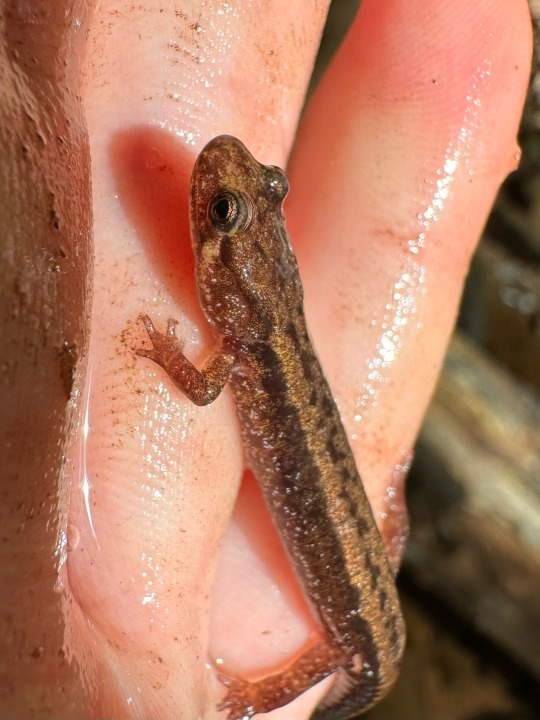


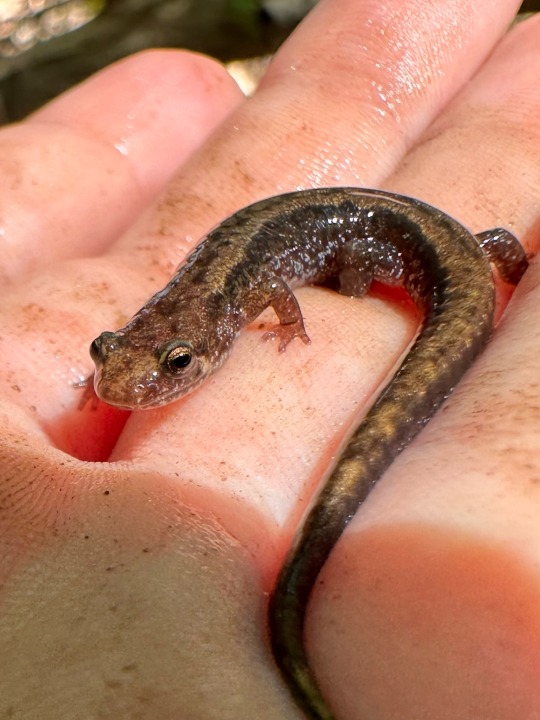
Today we have a salamander special, the Allegheny Mountain Dusky Salamander! Truly lovely
#I wish I found more salamanders#I seem to have terrible luck with them lol#but fortunately I found this dude#pretty neat#amphibian#amphibians#herpetology#herping#salamander#salamanders#dusky salamander
122 notes
·
View notes
Text

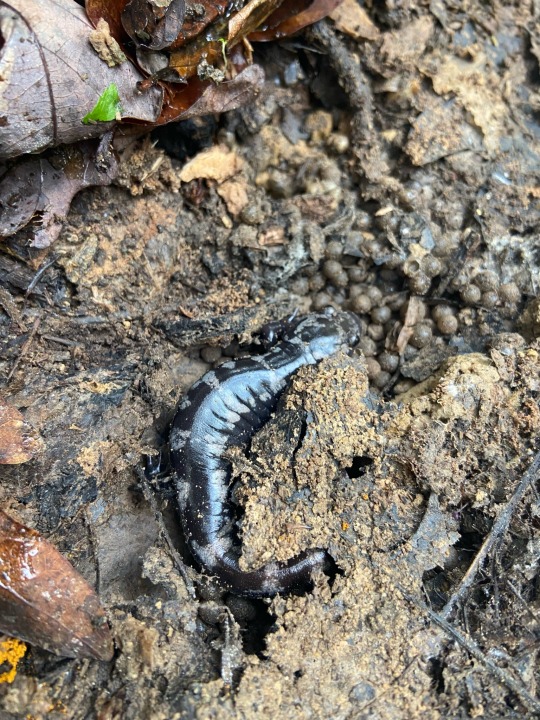


Salamanders galore!
Clockwise from top left: Dusky Salamander, Marble Salamander, E. Red Backed Salamander, Two Lined Salamander.
#nature#hike#gfdelmar og#herpetofauna#herpetology#marble salamander#salamanders#salamander#amphibians#amphibia#mosscore#eastern red backed salamander#dusky salamander#two lined salamander#dirtcore
33 notes
·
View notes
Photo

[Image: digital art of a brown salamander with bright orange “ear mark” coloration by its eye, light spots along its side, and faint orange-brown coloration along its back. End ID]
A new salamander species has been documented in the southeast US!
In a study published this month (May 2022) researchers demonstrate that the Pascagoula dusky salamander (Desmognathus pascagoula) is “morphologically, genetically, and geographically distinct” from other Desmognathus species.
The Pascagoula dusky salamander is found in swampy regions of southwestern Alabama and southeastern Mississippi. As stated in the abstract, “This discovery increases knowledge of the biodiversity in the southeastern United States Coastal Plain, a candidate region meeting the global criteria for a “biodiversity hotspot,” and underscores the amount of cryptic diversity likely remaining to be discovered and described in Nearctic salamanders.“
A new, narrowly endemic species of swamp-dwelling dusky salamander (Plethodontidae: Desmognathus) from the Gulf Coastal Plain of Mississippi and Alabama
CCAS professor helps discover new species of salamander near Gulf Coastal Plain | GW Hatchet
Pascagoula Dusky Salamander | MS Herps
#salamander#animal art#herps#herpetology#dusky salamander#good news#alabama#mississippi#ways i have typed ''salamander'' while doing this:#salander#slalmander#salmader#salamder
64 notes
·
View notes
Text

Dusky salamander
By: Leonard Lee Rue III/Bruce Coleman Ltd.
From: Éditions Rencontre Cards
1979
#dusky salamander#salamander#amphibian#1979#1970s#Leonard Lee Rue III#Bruce Coleman Ltd.#Éditions Rencontre Cards
11 notes
·
View notes
Text





Dusky salamanders!!
0 notes
Photo
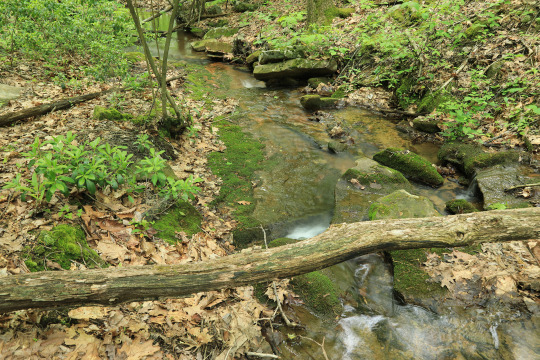
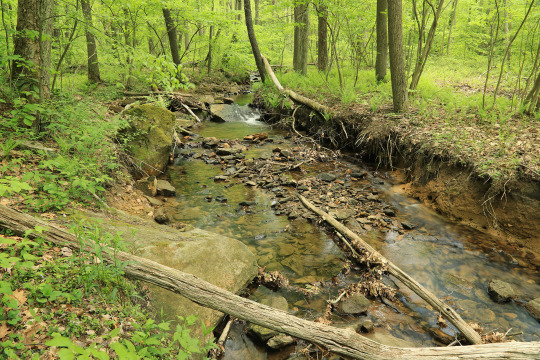

The seeps and headwaters that feed Appalachia's rivers and streams, such as Scott Run in Coopers Rock State Forest (above), are key to the local ecosystem’s ability to absorb, hold, and distribute water, control flooding, and maintain high quality habitat for the region’s incredible biodiversity. These source waters are the most vulnerable hydrologic features of the mountains, the first to be adversely impacted by mining and deforestation. Despite Appalachia's long struggle with devastating flooding and degraded water quality, work is underway in many parts of the region to restore previously-impaired lands and headwaters. That’s good news for this chubby Allegheny Mountain Dusky Salamander (bottom photo), which this past Saturday was busy with spring mating duties in one of the headwaters of Scott Run.
#appalachia#vandalia#west virginia#coopers rock state forest#scott run#hydrology#ecology#headwaters#ecosystem#environmental justice#desmognathus ochrophaeus#allegheny mountain dusky salamander#amphibian
229 notes
·
View notes
Text
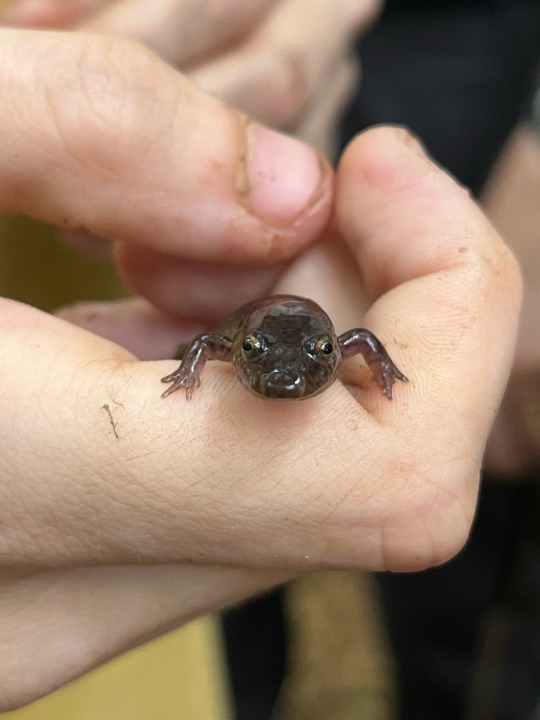

befriended some northern dusky’s during lab today :)
10 notes
·
View notes
Text
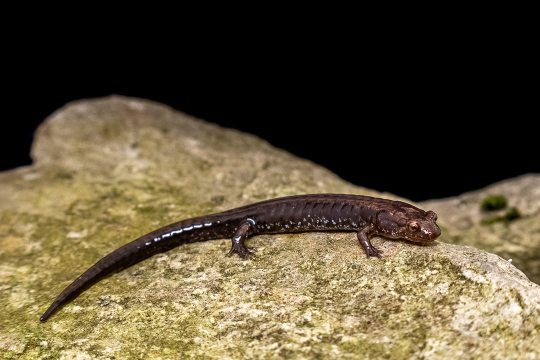

Allegheny Mountain Dusky Salamander (Desmognathus ochrophaeus), family Plethodontidae, Blackwater Canyon, West Virginia, USA
The Dusky Salamanders are rather hard to tell apart, so there is a possibility that this is Northern Dusky Salamander, D. fuscus, but sever characteristics point to this individual being D. ochrophaeus.
photograph by Frankie Gebhard
148 notes
·
View notes
Text
I would like to offer this resource for therians, an extensive list of all of Sir David Attenborough’s nature documentaries that are available on soap2day, and a full list of what species* they each (notably, prominently) feature the natural behaviors of, separated by episode, and omitting species that were only shown dead, juvenile or being predated on. This took me a while (I have been working on it since Prehistoric Planet’s release) because I did in fact have to watch every single series in full in order to list all the species and the episodes are around 50 minutes long, but enjoy.
Long post ahead:
Most of these shows have closed captioning, which is why I’ve picked soap2day. Planet Earth is the only one that doesn’t. I did not include Dynasties and Dynasties II because each episode only features one species.
Thank you to Birch (@ambiguousmutt) for his help (he watched about half of the episodes) so I didn’t have to do it individually. Credit goes to him as well.
*Sometimes Attenborough doesn’t say the specific species and I was too busy trying to get through the episodes to identify it. In those cases I just put the most specific name I could.
Planet Earth
Episode one (From Pole to Pole): emperor penguin, polar bear, caribou, arctic grey wolf, Amur leopard, six-plumed bird-of-paradise, superb bird-of-paradise, great white shark, African elephant, African buffalo, lechwe, baboon, African wild dog
Episode two (Mountains): gelada, walia ibex, Ethiopian wolf, guanaco, cougar, grizzly bear, markhor, snow leopard, golden eagle, grey wolf, panda, golden snub-nosed monkey, red panda, demoiselle crane
Episode three (Fresh Water): giant salamander, grizzly bear, smooth-coated otter, Nile crocodile, dolphin fish, midge, Amazon river dolphin, dorado, piranha, spectacled caiman, crab-eating macaque, snow goose
Episode four (Caves): wrinkle-lipped free-tailed bat, cockroach, bat hawk, cave swiftlet, yellow-red rat snake, Texas blind salamander
Episode five (Deserts): Bactrian camel, dromedary camel, red kangaroo, fennec fox, guanaco, long-nosed bat, Nubian ibex, flat lizard, lion, African elephant, locust
Episode six (Ice Worlds): snow petrel, Antarctic petrel, south polar skua, humpback whale, emperor penguin, eider, muskox, arctic grey wolf, polar bear, little auk, arctic fox
Episode seven (Great Plains): Mongolian gazelle, red-billed quelea, wildebeest, snow goose, arctic fox, arctic grey wolf, bison, wild ass, Tibetan fox, pygmy hog, African elephant, lion, baboon
Episode eight (Jungles): magnificent bird-of-paradise, spider monkey, howler monkey, siamang gibbon, gliding tree frog, colugo, red crab spider, African elephant, chimpanzee
Episode nine (The Shallow Seas): humpback whale, multiple corals, banded sea krait, trevally, dugong, bottlenose dolphin, Socotra cormorant, salp, comb jelly, sea lion, dusky dolphin, sea urchin, sunflower starfish, short-tailed stingray, great white shark, king penguin, fur seal
Episode ten (Seasonal Forests): Eurasian lynx, moose, crossbill, wolverine, western capercaillie, pine marten, great grey owl, pudu, kodkod, mandarin duck, cicada, red deer, Amur leopard, tiger, mouse lemur
Episode eleven (Ocean Deep): whale shark, oceanic whitetip shark, common dolphin, Cory's shearwater, manta ray, sea spider, vampire squid, spider crab, unnamed deep sea eel, giant isopod, chambered nautilus, Pacific spotted dolphin, mola mola, frigatebird, sailfish, blue whale
Planet Earth II
Episode one (Islands): pygmy three-toed sloth, Komodo dragon, sifaka, marine iguana, Galapagos racer, Buller's albatross, fairy tern, Christmas Island red crab, yellow crazy ant, chinstrap penguin
Episode two (Mountains): Nubian ibex, red fox, golden eagle, grizzly bear, bobcat, flamingo, mountain viscacha rat, snow leopard
Episode three (Jungles): spider monkey, flying lizard, sword-billed hummingbird, river dolphin, jaguar, glass frog, paper wasp, click beetle, red bird of paradise, Wilson's bird of paradise, indri
Episode four (Deserts): lion, Harris's hawk, shrike, locust, sand grouse, pale chanting goshawk, feral mustang, golden mole, desert long-eared bat, darkling beetle, Namaqua chameleon
Episode five (Grasslands): saiga antelope, lion, harvest mouse, carmine bee-eater, Kori bustard, African elephant, serval, Jackson's widowbird, grasscutter ant, compass termite, giant anteater, bison, red fox, arctic grey wolf
Episode six (Cities): langur, peregrine falcon, leopard, European starling, great bowerbird, raccoon, rhesus macaque, spotted hyena, wels catfish
Our Planet
Episode one (One Planet): lesser flamingo, orchid bee, golden-collared manakin, red-capped manakin, blue manakin, cormorant, booby, common dolphin, shearwater, African wild dog, timber wolf
Episode two (Frozen Worlds): gentoo penguin, wandering albatross, narwhal, Pacific walrus, humpback whale, orca, leopard seal, polar bear
Episode three (Jungles): lowland gorilla, forest elephant, black sicklebill, twelve-wired bird-of-paradise, western parotia, mountain treeshrew, Philippine eagle, black spider monkey, leafcutter ant, Sumatra orangutan, velvet worm
Episode four (Coastal Seas): northern fur seal, compass jellyfish, giant trevally, mobula ray, Atlantic stingray, bottlenose dolphin, grey reef shark, whitetip reef shark, sea otter, California sheephead wrasse, Steller's sea lion, bald eagle, humpback whale, Guanay cormorant, Inca tern, Peruvian booby, South American sea lion
Episode five (From Deserts to Grasslands): Socotran cormorant, Arabian leopard, Arabian oryx, African elephant, cheetah, bison, Alcon blue butterfly, saiga, Przewalski's wild horse, tiger
Episode six (The High Seas): blue whale, spinner dolphin, mobula ray, oarfish, anglerfish, bristle worm, giant petrel, black-browed albatross, wandering albatross, bluefin tuna, sea lion, humpback whale
Episode seven (Fresh Water): Australian pelican, torrent duck, grizzly bear, manatee, giant mayfly, common kingfisher, osprey, jaguar, callipterus cichlid, Siamese fighting fish, hippopotamus, lion, African elephant, sandhill crane
Episode eight (Forests): Siberian tiger, bald eagle, rough-skinned newt, great hornbill, African elephant, African wild dog, fossa, gray mouse lemur
A Perfect Planet
Episode one (Volcano): lesser flamingo, marabou stork, Galápagos land iguana, vampire ground finch, Aldabra giant tortoise, North American river otter, coyote, Kamchatka brown bear, wildebeest
Episode two (The Sun): yellow-cheeked gibbon, fig wasp, arctic grey wolf, wood frog, garter snake, arctic fox, Saharan silver ant, golden snub-nosed monkey, sooty shearwater, humpback whales
Episode three (Weather): straw-colored fruit bat, fire ant, Amazonian giant river turtle, desert rain frog, Bactrian camel, Christmas Island red crab, carmine bee-eater, Nile crocodile, African fish eagle, hippopotamus
Episode four (Oceans): common dolphin, marine iguana, flightless cormorant, flamboyant cuttlefish, eider, bottlenose dolphin, lemon shark, manta ray, blacktip reef shark, trevally, rockhopper pengin, Eden's whale
Episode five (Humans): none
Life
Episode one (Challenges of Life): bottlenose dolphins, cheetah, panther chameleon, orca, brown-tufted capuchin, stalk-eyed fly, hippopotamus, Clark's grebe, giant Pacific octopus, strawberry poison-dart frog, leopard seal, orangutan
Episode two (Reptiles and Amphibians): pebble toad, caiman, basilisk, Brazilian pygmy gecko, panther chameleon, Namaqua chameleon, red-sided garter snake, collared iguana, hog-nosed snake, horned lizard, sea krait, African bullfrog, Komodo dragon
Episode three (Mammals): Weddell seal, elephant shrew, aye-aye, caribou, straw-colored fruit bat, lion, spotted hyena, polar bear, brown-nosed coati, meerkat, African elephant, humpback whale
Episode four (Fish): sailfish, flying fish, weedy sea dragon, convict fish, sarcastic fringehead, mudskipper, Hawaiian freshwater goby, hippopotamus, barbel, silvertip shark, clownfish, sea lion, ragged tooth shark, multiple snapper, whale shark
Episode five (Birds): spatuletail hummingbird, lammergeier, red-billed tropicbird, magnificent frigatebird, red knot, horseshoe crab, lesser flamingo, chinstrap penguin, great white pelican, Clark’s grebe, sage grouse, Vogelkop bowerbird
Episode six (Insects): Darwin’s beetle, unnamed damselfly, monarch butterfly, alkali fly, Wilson’s phalarope, oogpister beetle, mongoose, bombardier beetle, honey bee, black bear, Japanese red bug, Dawson’s bee, grass cutter ant
Episode seven (Hunters and Hunted): ibex, short-tailed stoat, brown bear, Ethiopian wolf, California ground squirrel, star-nosed mole, cheetah, red fox, greater bulldog bat, bottlenose dolphin, Bengal tiger, rattlesnake, orca
Episode eight (Creatures of the Deep): Pompeii worm, Humboldt squid, nemertean worm, moon jelly, fried egg jellyfish, spider crab, stingray, cuttlefish, giant Pacific octopus, sunflower sea star, king crab, cleaner shrimp
Episode nine (Plants): monarch butterfly, purple-throated carib hummingbird
Episode ten (Primates): Hamadryas baboon, Japanese macaque, lowland gorilla, spectral tarsier, phayre's leaf monkey, ring-tailed lemur, Sumatra orangutan, chacma baboon, white-faced capuchin, brown-tufted capuchin, western chimpanzee
Blue Planet II
Episode one (One Ocean): bottlenose dolphin, tuskfish, tern, giant trevally, mobula ray, false killer whale, Asian sheepshead wrasse, orca, humpback whale, walrus
Episode two (The Deep): sea toad, Venus’ flower basket, unnamed shrimp, ethereal snailfish, cock-eyed squid, pyrosome, barrel-eyed fish, unnamed siphonophore, yeti crab, Humboldt squid, fangtooth fish, sixgill shark, scabbardfish, zombie worm
Episode three (Coral Reefs): broadclub cuttlefish, coral grouper, day octopus, multiple corals, green turtle, bottlenose dolphin, manta ray, bobbit worm, saddleback clownfish, marbled grouper, grey reef shark
Episode four (Big Blue): spinner dolphin, yellowfin tuna, mobula ray, sailfish, sperm whale, sea turtle, blue shark, great white shark, multiple jellyfish, Portuguese man o' war, whale shark, wandering albatross, shortfin pilot whale
Episode five (Green Seas): Garibaldi, Australian giant cuttlefish, weedy seadragon, common octopus, pyjama shark, sea otter, tiger shark, smooth stingray, zebra mantis shrimp, common dolphin, humpback whale
Episode six (Coasts): Pacific leaping blenny, king penguin, southern elephant seal, Sally Lightfoot crab, Galápagos sea lion, ochre starfish, clingfish, chain moray eel, Atlantic puffin, arctic skua
Episode seven (Our Blue Planet): none
Prehistoric Planet
Episode one (Coasts): Tyrannosaurus rex, Tethydraco, Phosphatodraco, Tuarangisaurus, Mosasaurus hoffmannii, pycnodont fish, ammonites, Kaikaifilu
Episode two (Deserts): Dreadnoughtus, Tarbosaurus, Velociraptor, Mononykus, Barbaridactylus, Secernosaurus
Episode three (Freshwater): Velociraptor, Tyrannosaurus rex, Deinocheirus, Quetzalcoatlus, Masiakasaurus, Beelzebufo, elasmosaur
Episode four (Ice Worlds): dromaeosaur, hadrosaur, Ornithomimus, Olorotitan, troodontid, Antarctopelta, Pachyrhinosaurus, Nanuqsaurus
Episode five (Forests): Austroposeidon, Triceratops, Carnotaurus, Qianzhousaurus, Edmontosaurus, Atrociraptor, Anodontosaurus, Therizinosaurus, Telmatosaurus, Hatzegopteryx
The Hunt
Episode one (The Hardest Challenge): African leopard, African wild dog, Parson’s chameleon, nose-horned chameleon, African mantis, Darwin’s bark spider, Nile crocodile, Amur falcon, orca, cheetah
Episode two (Arctic): polar bear, arctic grey wolf, arctic fox, glaucous gull
Episode three (Forests): tiger, American marten, sparrow hawk, Portia spider, tarsier, harpy eagle, chimpanzee, army ant
Episode four (Oceans): blue whale, frigatebird, dorado, sargassum fish, spinner dolphin, Beroe ovata, Chiroteuthis, lionfish, black-browed albatross, sea lion, tuna, copper shark, common dolphin, Bryde's whale
Episode five (Plains): cheetah, caracal, honey badger, termite, bald eagle, lion, Ethiopian wolf, hotrod ant, spoor spider
Episode six (Coasts): bottlenose dolphin, algae octopus, sand bubbler crab, long-tailed macaque, marine otter, grizzly bear, grey wolf, peregrine falcon, orca, humpback whale
Episode seven (Conservation): none
Life In Colour
Episode one (Seeing In Color): Indian peafowl, mandrill, Costa’s hummingbird, magnificent bird-of-paradise, blue moon butterfly, fiddler crab, mantis shrimp, flamingo, poison dart frog
Episode two (Hiding In Color): Bengal tiger, langur, ptarmigan, crab spider, zebra, Cuban painted snail, blue-striped fangblenny, common waxbill, pin-tailed wydah, Augrabies flat lizard
Frozen Planet II
Episode one (Frozen Worlds): emperor penguin, orca, Pallas’s cat, Siberian tiger, grizzly bear, hooded seal, polar bear
Episode two (Frozen Ocean): polar bear, beluga, harp seal, skeleton shrimp, crested auklet, orca
Episode three (Frozen Peaks): high-casqued chameleon, japanese macaque, kea, andean flamingo, giant panda, golden eagle, andean mountain lion
Episode four (Frozen South): king penguin, Antipodean wandering albatross, blue whale, Weddell seal, chinstrap penguin, snow petrel, leopard seal, orca
Episode five (Frozen Lands): grey wolf, arctic fox, Amur leopard, Siberian tiger, painted turtl, Lapland bumblebee, snowy owl, caribou, grizzly bear
Episode six (Our Frozen Planet): none
Africa
Episode one (Kalahari): fork-tailed drongo, ostrich, black rhinoceros, Angolan giraffe, African leopard, armored ground cricket, spider wasp
Episode two (Savannah): Agama lizard, shoebill, bee-eaters and rollers, lesser flamingo, African elephant, crowned eagle, African fish eagle, martial eagle
Episode three (Congo): chimpanzee, central African rock python, Angola banana frog, African skimmer, rockfowl, African elephant
Episode four (Cape): emperor swallowtail, giant kingfish, African penguin, monkey beetle, springbok, yellow-billed kite, pied crow, ghost crab, vundu catfish, Nile crocodile, Bryde’s whale, great white shark, common dolphin
Episode five (Sahara): Grevy’s zebra, naked mole rat, barn swallow, Dromedary camel, dung beetle, crocodile, western yellow wagtail, Saharan silver ant
Episode six (The Future): none
522 notes
·
View notes
Text
Monstrous Fusion Archive
Character Concepts
Artisan -
Engie - Tattoos
Eras - Proxi
Faye - Kitsune
Feathers -
Minish - Zeffa
Mirror - Hare form /
Tune - tattoos
Rancher - Dusky
Wild -
Zonau -
Extras
Camping trip / Springtime / Fun Facts + Faye Markings
Doodles
Sleepy Cuddles
Teefs
Bunny Whisperer
Boop!!
AUs within the AU
A sleepy afternoon
Engie's Umbrella
Salamander
13 notes
·
View notes
Photo

Today the river fulfilled one of my lifelong dreams by introducing me to this wee salamander at the end of my river cleaning. I could feel their tiny heartbeat in my hand and felt deeply blessed. The best I can tell, they were some sort of dusky salamander, who I carefully put back after this. #trashwalk #rivercleanup #rivercleaning #salamander #duskysalamander #river #stream #mountains https://www.instagram.com/p/CoYcu1mrNSJ/?igshid=NGJjMDIxMWI=
25 notes
·
View notes
Note
BLU 💥💥👽 i have MORE PHOTO for you. mostly salamanders bc i am doing research on them but also there's a crayfish and a stonefly larvae (i think) and a ghost pipe! whivh i just thought looked cool. 😎😎 all the salamanders are blue ridge duskys but one of the salamanders i found i couldn't identify (the one in the third photo) because they they were a larvae, and my friend also found a seal salamander but we didn't get a photo






i also sunk into the mud up to my knees and got stuck which was fun but i was wearing a tank top and i got hit with a shit ton of stinging nettle trying to get out. my arms hurt so ba d 🦑🦑
-goblin five but more evil than normal
Maybe Allegheny? Not sure. But the plant is defo ghost pipe! :]
9 notes
·
View notes
Text
[CM] Amphibians
Amphibians! These words were all very fun to come up with. Who doesn’t like listening to frog sounds? Below we have translations for four frogs, three salamanders, and one fellow with a name from base Clanmew.
Common toad (Bufo bufo) - Amam*
Small and common. Poisonous to eat, but some cats like to chase them anyway.
Spring peeper (Pseudacris crucifer) - Eep
Tiny chorus frog with light peeping calls that are a tell-tale sign of spring. This word is also an unintentional homonym with base Clanmew eep*, which means black rat!
Bullfrog (Lithobates catesbeianus) - Rroak
Large distinct frog with a loud, deep call. A common game among apprentices is ranging up-and-down riverbanks and looking for bullfrogs to startle into the water.
Green frog (Rana clamitans) - Ook
Second-largest frog on ClayClan territory. Green frogs are very territorial - some cats like to watch them wrestle!
Pickerel frog (Lithobates palustris) - Rroo
Heavily spotted frog. Stressed pickerel frogs produce a toxic secretion that makes them poisonous to eat; it may also irritate skin.
Wood frog (Lithobates sylvaticus) - Rrikrrik
Brown-and-black frog. Sometimes found frozen in the dead of winter - cats believe them to be dead during this time, but they actually thaw in the spring!
Spotted salamander (Ambystoma maculatum) - Sslip
Large salamander with distinct yellow spots. Bitter and poisonous, never hunted.
Dusky salamander (Desmognathus fuscus) - Mwip
Mottled and relatively nondescript salamander. Occasionally found foraging in wet shady spots.
Common newt (Lissotriton vulgaris) - Ssliks
Little spotted newt. Found on land most of the year, but move into ponds for the breeding season. Also known as efts; the acolyte Eftrunner’s Claymew name, Sslikspanpean, could also be translated as Newtrunner.
5 notes
·
View notes
Text
Went herping in the blue ridge mountains and found some lovely friends!




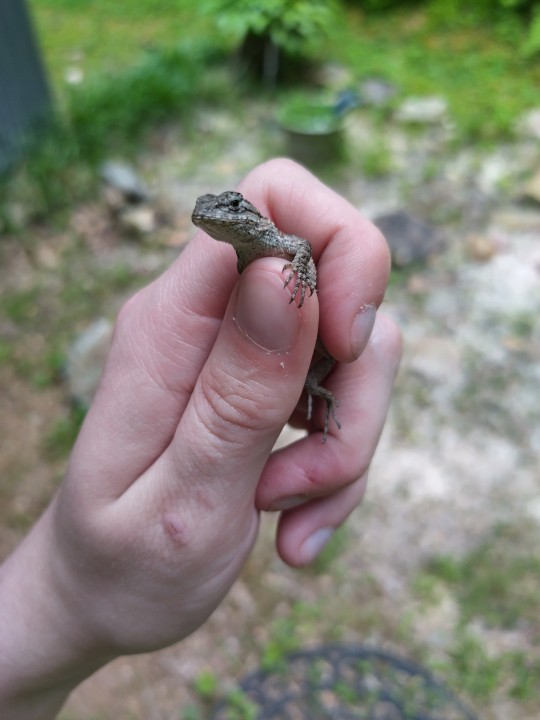

1 and 2: A lovely eastern box turtle (Terrapene carolina carolina) with bright orange patterns. In person it was nearly red! Likely an adult male, he was rather big and lively.
3: Another eastern box turtle, this one around the same size with light yellow patterns. Probably a female, and given the proximity to the male I'm hoping she's gravid since they're a vulnerable species. I didn't want to bother her much and kept my distance.
4 and 5: A small eastern fence lizard (Sceloporus undulatus) was probably about a year old judging by the size. The cinder blocks also had a five-lined skink (Plestiodon fasciatus) with a missing tail and two broad-headed skinks (Plestiodon laticeps) who were fighting for territory. The skinks were way too fast to catch and I wasn't able to get food pictures of them. :(
6: There were hundreds, if not thousands, of baby salamanders. Possibly red-backed salamanders (Plethodon cinereus) because they're so tiny and not in a larval stage, although it's hard to tell with the dim lighting. I've also seen northern dusky salamanders (Desmognathus fuscus) in the area. The mountain spring was gorgeous and probably one of the cleanest water sources I've ever seen. You could drink right from the spring box, and the place I was staying was on the same aquifer.
Not pictured is a HUGE black racer (Coluber constrictor) that made a home in a collapsed shed. It was easily over six feet long and very handsome. I wish I had my phone when I saw it because it was gorgeous.
7 notes
·
View notes
Text
@foxindarkness asked
Hey! I think you haven't done Nan Elmoth yet in your flora and fauna series, and I'd really really love to see your take on it, especially if you feel like making one of your gorgeous boards to go with it!
Flora, fauna, geography and environment of Arda
As always this is not a complete list! Please always feel free to ask for more details about any category (birds, fern, spring plants, etc)
Nan Elmoth or the Valley of Stars was a deep forest East of Doriath and on the Eastern banks of the river Celon, a tributary to Aros which was itself a tributary to Sirion.
We can only speculate about the species of trees that grew here with the primary descriptor being that they block the sun.
The climate and habitat is a deep, mixed deciduous forest with high moisture, higher than most of Doriath.
Mountain ash or Rowan, common beech and oak, and some towering pine trees are the most common species. Importantly, Yew trees grow throughout Nan Emloth and produce patches of near darkness where little else can grow.
Field and wych elms grow by the banks of Celon, needing the moist, sandy soil.
Bitter or woody nightshade grows throughout the vale as does arum, sweet violet, Great sallow, soft rush, royal ferns and bracken, common fragile fern, baneberry, black touch me not
Green shield moss, silky forklet moss, thyme moss and grey-cushioned grimmia are examples of species of mosses that grow on land in the valley.
Destroying angel mushrooms grow in the birch groves and funeral bell, panther’s cap, false death cap, bay bolete, lichens like Cladonia bellidiflora, Lobaria virens and beard lichens grow throughout on and around both decaying and healthy trees.
There was apparently a small lake or pool called Gladuial. This was likely a spring fed by ground water or a vestigial pool that remained fed by precipitation throughout the year
Common water moss clings to rocks in the river Celon, thriving in the shade the trees of Nan Emloth provide. Water starwort also grows here.
There are a number of vernal pools dotted throughout the forest Small vernal pools like these are always wonderfully diverse mini ecosystems.
Curled pondweed, amphibious bistort, bur-reed, frogbit, and least duckweed among other plants grow in these.
In the spring and summer, the chorus of frogs alights the forest at night and throughout much of the day
Pool frogs and agile frogs are the most common species though common tree frogs.
Smooth newts, palmate newts, and fire salamanders can also be found.
Crested newts can be found in small pools in less shaded areas closer to the riverbank
The forest is a quiet one and songbirds are rare and unnaturally taciturn during all but a few hours each day
Common nightjar, common nightingale, and red necked nightjar
Thrushes love the berries of yew trees which are poisonous to most others. Common blackbirds, redwings, mistle thrush.
Butterflies flit in open groves, feeding on the elm, birch and herbaceous plants of the vale. These include autumnal moth, wood white, and mourning cloak among others
Mollusks can be found in both the freshwater and terrestrial habitats of the forest. Point snails, Platyla gracilis, dusky arion slug, pond snails (Galba truncatula), and marsh slug among others.
Like in the Nan Tathren, large animals are rare in Nan Emloth. Those that do enter the valley are elusive
I like to think about prehistoric creatures roaming the lands around Doriath specifically Nan Emloth and the lands North of Neldoreth. I can make a post about that in more detail if there’s interest!
27 notes
·
View notes
Text


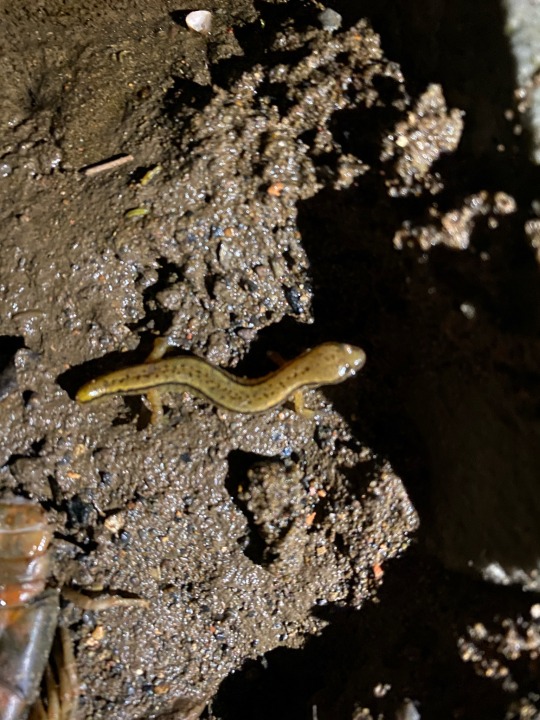
Got sad last night. Went to creek and saw salamander about it. Thinking this is an allegheny mountain dusky salamander. Looks like his ass got bit off and he's regenerating it now.
He is a northern two-lined salamander!
0 notes